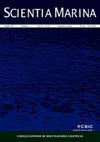Effects on faunistic composition and population characteristics of decapod crustaceans after the implementation of a fisheries no-take area in the NW Mediterranean
IF 0.9
4区 生物学
Q4 MARINE & FRESHWATER BIOLOGY
引用次数: 0
Abstract
The establishment of fisheries no-take areas is considered an effective method for the recovery of populations of exploited species and their habitats. Here we study the faunistic composition of decapod crustaceans after the implementation of a no-take area in the Gulf of Roses (NW Mediterranean) in 2014. We studied the occurrence (presence/absence) and density of all decapod crustaceans sampled by trawling inside and outside a no-take area from March 2015 to July 2018. Sizes were assessed for all common species. A total of 33 species of decapod crustaceans were recorded. Four species showed significantly higher occurrences in the no-take area and three in the open area, while significantly higher densities were found for four species in the no-take area and three in the open area. Multivariate analysis showed marked differences between the no-take area and the open area, while also showing that the two areas were undergoing a divergence. The comparison of sizes between the two zones showed species-specific patterns that in many cases showed that both the smallest and the largest individuals were present in the no-take area, suggesting that the closing of this area would be important for recruitment and juvenile development, as well as for protection of large-sized individuals. All evidence indicates that the establishment of the no-take area has led to an improvement in biodiversity and species population descriptors.地中海西北部渔业禁捕区实施后对十足目甲壳类动物区系组成和种群特征的影响
建立渔业禁渔区被认为是恢复被开采物种种群及其栖息地的有效方法。在这里,我们研究了2014年在玫瑰湾(地中海西北部)实施禁捕区后十足目甲壳类动物的区系组成。我们研究了2015年3月至2018年7月在禁捕区内外通过拖网捕鱼采样的所有十足目甲壳类动物的出现(存在/不存在)和密度。对所有常见物种的体型进行了评估。共记录了33种十足目甲壳类动物。四个物种在禁捕区和三个在开放区的出现率明显较高,而在禁捕区域和三个开放区的密度明显较高。多变量分析显示,无拍摄区域和开放区域之间存在显著差异,同时也表明这两个区域正在发生差异。对两个区域大小的比较显示,物种特有的模式在许多情况下表明,最小和最大的个体都存在于禁捕区,这表明关闭该区域对招募和青少年发育以及保护大型个体都很重要。所有证据都表明,禁捕区的建立改善了生物多样性和物种种群描述。
本文章由计算机程序翻译,如有差异,请以英文原文为准。
求助全文
约1分钟内获得全文
求助全文
来源期刊

Scientia Marina
生物-海洋与淡水生物学
CiteScore
2.10
自引率
0.00%
发文量
21
审稿时长
6-12 weeks
期刊介绍:
Scientia Marina is the successor to Investigación Pesquera, a journal of marine sciences published since 1955 by the Institut de Ciències del Mar de Barcelona (CSIC). Scientia Marina is included in the Science Citation Index since 1998 and publishes original papers, reviews and comments concerning research in the following fields: Marine Biology and Ecology, Fisheries and Fisheries Ecology, Systematics, Faunistics and Marine Biogeography, Physical Oceanography, Chemical Oceanography, and Marine Geology. Emphasis is placed on articles of an interdisciplinary nature and of general interest.
 求助内容:
求助内容: 应助结果提醒方式:
应助结果提醒方式:


